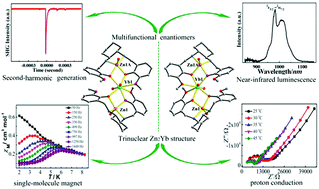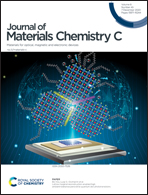Multifunctional Zn(ii)–Yb(iii) complex enantiomers showing second-harmonic generation, near-infrared luminescence, single-molecule magnet behaviour and proton conduction†
Abstract
A new pair of multifunctional Zn(II)–Yb(III) complex enantiomers based on a chiral amine-phenol ligand, [YbZn2(SS/RR-L)2(H2O)4](ClO4)3·5H2O (S-1 and R-1) [H2L = (SS/RR)-cyclohexane-1,2-diylbis(azanediyl)-bis(methylene)-bis(2-methoxyphenol)], were synthesized and structurally characterized. In S-1 and R-1, the linear Zn(II)–Yb(III)–Zn(II) metal core is bridged by the phenolate oxygen atoms. Enantiomers S-1 and R-1 show chiroptical activity. Complex S-1 exhibits second-harmonic generation (SHG) and YbIII characteristic emissions in the near-infrared (NIR) region. Magnetic studies indicate that S-1 shows single-molecule magnet (SMM) behaviour. Moreover, S-1 displays a high proton conductivity of 1.55 × 10−4 S cm−1 at room temperature under 100% relative humidity (RH), which results from a 1D H-bonded chain constructed by NH groups of the chiral amine-phenol ligand, water molecules and perchlorate anions (ClO4−). The combination of these five-functions, including chiral, nonlinear optical, magnetic, luminescent and proton-conductive properties, in molecule-based materials may provide great potential for application in smart multifunctional devices.



 Please wait while we load your content...
Please wait while we load your content...